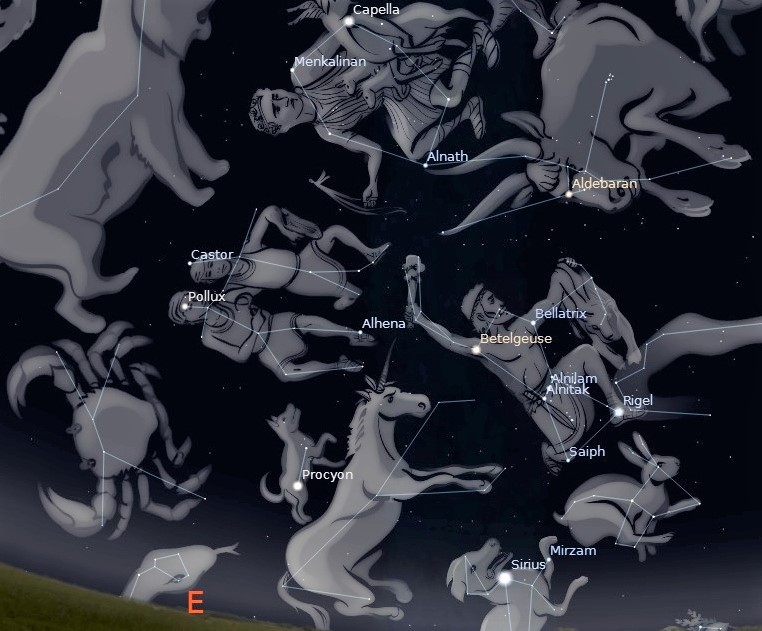This Week’s Sky at a Glance, 2021 December 18 – 25
~by Curt Nason
Having official constellations doesn’t prevent us from imagining our own. The sight of Orion, with club raised high and a lion-skin shield warding off the horns of a raging bull, has been etched in my memory for over half a century. But, come December, reddish Betelgeuse in Orion’s armpit becomes Santa’s red nose in profile, the curve of the shield outlines a sack of toys, and the iconic three-star belt is…well, Santa’s wide black leather belt. And on cold, clear nights there is no mistaking that twinkle in his eye. Look to the north and there is Santa’s sleigh, usually seen as the Big Dipper, being loaded up for the long night’s ride.
Many doors and windows are decorated with wreaths and the window of the winter sky is no exception. Here, Betelgeuse is a red light near the middle of a wreath we call the Winter Circle or Hexagon. By mid-evening you can trace the lights decorating the wreath, from blue-white Rigel in Orion’s leg to brilliant Sirius the Dog Star, up through Procyon the Little Dog Star, around Pollux and Castor in Gemini and Capella in Auriga to orange Aldebaran as the Bull’s eye, and back to Rigel. Imagination is a gift and Santa won’t mind if you open yours before Christmas.
This Week in the Solar System
Saturday’s sunrise in Moncton is at 7:56 am and sunset will occur at 4:34 pm, giving 8 hours, 38 minutes of daylight (7:58 am and 4:43 pm in Saint John). Next Saturday the Sun will rise at 8:00 am and set at 4:38 pm, giving 8 hours, 38 minutes of daylight (8:02 am and 4:46 pm in Saint John). The Sun reaches its most southerly point on Tuesday at 11:59 am, our shortest daylight of the year, to kick off winter.
The Long Night’s Full Moon occurs on Sunday, taking 15 hours and 47 minutes to cross the sky. There will be a lot of wolves with sore throats on Monday. (Wolves don’t howl at the Moon, by the way, they just howl.) Mercury sets 35 minutes after sunset this Saturday and stretches that gap to an hour next weekend. Venus is moving rapidly in the opposite direction and the two inner planets cross paths on New Year’s Eve. Saturn sets at 8 pm midweek, followed by Jupiter an hour and a half later. Mars can be seen with binoculars in the morning sky, rising shortly after 6 am.
Comet C/2021 A1 Leonard might be seen in binoculars about a binocular-width below Venus around 5:30 pm on Saturday. Over the week it passes southward along the horizon at the same time, well below Saturn on Monday and Jupiter next weekend.
Questions? Contact Curt Nason.

